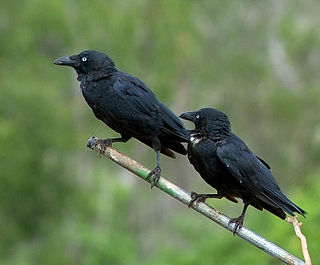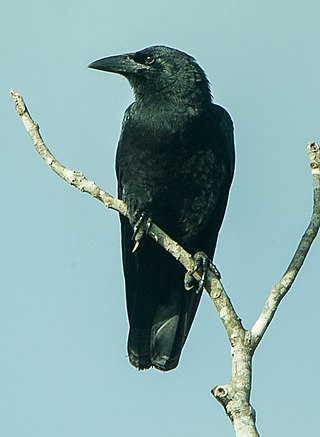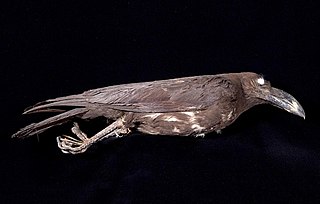
The Australian raven is a passerine bird in the genus Corvus native to much of southern and northeastern Australia. Measuring 46–53 centimetres (18–21 in) in length, it has all-black plumage, beak and mouth, as well as strong grey-black legs and feet. The upperparts are glossy, with a purple, blue, or green sheen, and its black feathers have grey bases. The Australian raven is distinguished from the Australian crow species by its throat hackles, which are prominent in adult birds. Older adult individuals have white irises, younger adults have white irises with an inner blue rim, while younger birds have dark brown irises until fifteen months of age, and hazel irises with an inner blue rim around each pupil until age two years and ten months. Nicholas Aylward Vigors and Thomas Horsfield described the Australian raven in 1827, its species name (coronoides) highlighting its similarity with the carrion crow. Two subspecies are recognized, which differ slightly in calls and are quite divergent genetically.

The Torresian crow, also called the Australian crow or Papuan crow, is a passerine bird in the crow family native to the north and west of Australia and nearby islands in Indonesia and Papua New Guinea. The species has a black plumage, beak and mouth with white irises. The base of the feathers on the head and neck are white. The Torresian crow is slightly larger with a more robust bill than the morphologically similar little crow.

The forest raven, also commonly known as the Tasmanian raven, is a passerine bird in the family Corvidae native to Tasmania and parts of southern Victoria, such as Wilsons Promontory and Portland. Populations are also found in parts of New South Wales, including Dorrigo and Armidale. Measuring 50–53 cm (20–21 in) in length, it has all-black plumage, beak and legs. As with the other two species of raven in Australia, its black feathers have grey bases. Adults have white irises; younger birds have dark brown and then hazel irises with an inner blue rim. New South Wales populations are recognised as a separate subspecies C. tasmanicus boreus, but appear to be nested within the Tasmanian subspecies genetically.

The little raven is a species of the family Corvidae that is native to southeastern Australia. An adult individual is about 48–50 cm (19–19.5 in) in length, with completely black plumage, beak, and legs; as with all Australian species of Corvus, the black feathers have a grey base, and the iris of the adult bird is white . Although the little raven was first named by Gregory Mathews in 1912, it was only in 1967 that there was consensus to separate it from the Australian raven as a distinct species.

The pied crow is a widely distributed African bird species in the crow genus of the family Corvidae.

The large-billed crow, formerly referred to widely as the jungle crow, is a widespread Asian species of crow. It is very adaptable and is able to survive on a wide range of food sources, making it capable of colonizing new areas, due to which it is often considered a nuisance, especially on islands. It has a large bill, which is the source of its scientific name macrorhynchos and it is sometimes known by the common name thick-billed crow. It can also be mistaken for a common raven. Johann Georg Wagler first described the species from a holotype obtained from Java in the year 1827. The eastern jungle crow and Indian jungle crow were once considered conspecific and together called the jungle crow.

The Cuban crow is one of four species of crow that occur on islands in the Caribbean. It is closely related to the white-necked crow and Jamaican crow, with which it shares similar features. The fourth Caribbean crow, the palm crow, is a later arrival in evolutionary terms, and shows characteristics more akin to North American species, such as the fish crow, which it is probably closely related to.

The white-necked crow is the largest of the four Caribbean corvids. It is endemic to the island of Hispaniola ; it was formerly also extant on Puerto Rico, but has been extirpated there due to considerable forest clearance and hunting.

The gray crow, formerly known as the bare-faced crow, is about the same size as the Eurasian carrion crow but has somewhat different proportions and quite atypical feather pigmentation during the juvenile phase for a member of this genus.

Stresemann's bushcrow, also known as the Abyssinian pie, bush crow, Ethiopian bushcrow, or by its generic name Zavattariornis, is a rather starling-like bird, which is a member of the crow family, Corvidae. It is slightly larger than the North American blue jay and is a bluish-grey in overall colour which becomes almost white on the forehead. The throat and chest are creamy-white with the tail and wings a glossy black. The black feathers have a tendency to bleach to brown at their tips. The iris of the bird is brown and the eye is surrounded by a band of naked bright blue skin. The bill, legs, and feet are black.

The white-billed crow is a member of the crow family found on the Solomon Islands.

The Halmahera paradise-crow also known as the silky crow, is a medium-sized crow-like bird-of-paradise.

The crow honeyeater is a very large honeyeater endemic to humid forests in New Caledonia in the South Pacific.

The purplish-backed jay is a bird of the crow family Corvidae, with purple feathers on its back, wings, and tail and black feathers elsewhere. It is endemic to northwestern Mexico, where its habitat is mainly dry deciduous forest. The International Union for Conservation of Nature has assessed it as being a "species of least concern".

The Moluccan megapode, also known as Wallace's scrubfowl, Moluccan scrubfowl or painted megapode, is a small, approximately 31 cm long, olive-brown megapode. The genus Eulipoa is monotypic, but the Moluccan megapode is sometimes placed in Megapodius instead. Both sexes are similar with an olive-brown plumage, bluish-grey below, white undertail coverts, brown iris, bare pink facial skin, bluish-yellow bill and dark olive legs. There are light grey stripes on reddish-maroon feathers on its back. The young has brownish plumage, a black bill, legs and hazel iris.

The Banggai crow is a member of the crow family from Banggai regency in the province of Central Sulawesi in Indonesia. It is listed as critically endangered by IUCN. It was feared extinct, but was finally rediscovered during surveys on Peleng Island off the southeast coast of Sulawesi by Indonesian ornithologist Mochamad Indrawan in 2007 and 2008.

The black wood pigeon or Japanese wood pigeon is a species of bird in the family Columbidae. It is found in East Asia along shorelines of the Pacific's Korea Strait, Philippine Sea and East China Sea. It is believed to be the largest representative of the genus, Columba, and has a weight of around 550 grams (1.2 lb) and an overall length of 43 cm (17 in). Its natural habitats are temperate forests and subtropical or tropical moist lowland forests. The species is in decline owing to habitat loss, habitat degradation, deforestation and hunting. This wood pigeon is endemic to the laurel forest habitat.

The brown-headed crow is a passerine bird of the genus Corvus in the family Corvidae. Endemic to Indonesia, it has a fragmented distribution in subtropical or tropical moist lowland forest and subtropical or tropical mangrove forest. It is threatened by habitat destruction and the IUCN has rated it as being "near-threatened".
The Bougainville crow is a species of bird in the crow family, Corvidae.

The silvery-throated jay is a species of bird in the family Corvidae. It is found in the Talamancan montane forests of Costa Rica and western Panama. The IUCN has rated its conservation status as being of "least concern".




















